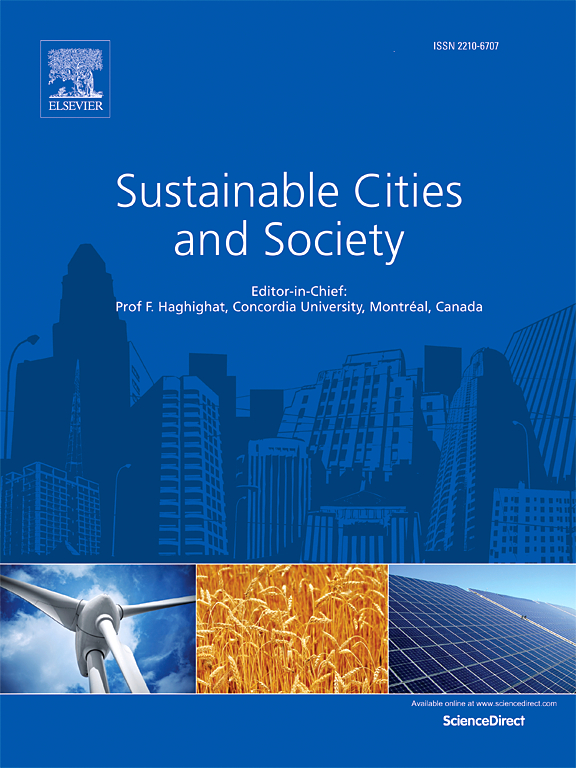基于机器学习和降尺度的大城市热岛时空评价与监测
IF 10.5
1区 工程技术
Q1 CONSTRUCTION & BUILDING TECHNOLOGY
引用次数: 0
摘要
城市热岛是人类对土地进行改造而导致的一种重要现象。用于研究UHIs对气温影响的数值模型需要高分辨率才能准确估计空间场。本研究采用统计和动态降尺度方法,从天气研究与预报(WRF)模型输出的1公里分辨率的气温场估计城市热岛(UHI),该模型最初以5公里的粗分辨率生成,用于里约热内卢大都会区(MARJ)。在动态方法中,WRF模型的三个域为25-5-1 km,通过嵌套系统得到空间分辨率为1 km的网格。后者与单层城市冠层模型(SLUCM)耦合。统计方法引入了一种基于极端梯度增强机器学习算法的新方法,该方法通过1次多元非线性回归将1公里尺度上的气温与地理景观变量关联起来。此外,SHAP分析应用于评估机器学习模型中的单个特征贡献。利用气象站测得的大气温度和遥感数据估算的大气温度,对这些降尺度方法的性能进行了评价。两种方法都能令人满意地模拟巴西首都地区UHIs的时空行为,但统计方法的计算成本明显较低。这一结果证明了这种基于机器学习的方法作为有限计算资源下研究和监测UHI的替代方法的可行性。本文章由计算机程序翻译,如有差异,请以英文原文为准。
Spatiotemporal assessment and monitoring of urban heat islands in metropolitan areas using machine learning and downscaling
Urban heat islands (UHI) are a significant phenomenon that results from human modification of the land. Numerical models that are used to study the impacts of UHIs on air temperature require high resolution to estimate spatial fields accurately.This study employs both statistical and dynamic downscaling methods to estimate urban heat islands (UHI) from 1 km-resolution air temperature fields from outputs of the Weather Research and Forecasting (WRF) model, initially generated at a coarser resolution of 5 km, for the Metropolitan Area of Rio de Janeiro (MARJ). In the dynamic method, a grid with 1 km spatial resolution is obtained through a nesting system with three domains of the WRF model of 25–5–1 km. The latter domain couples to the Single-Layer Urban Canopy Model (SLUCM). The statistical approach introduces a novel methodology based on the extreme gradient boosting machine learning algorithm, which correlates air temperature with physiographic landscape variables on a scale of 1 km by 1 multiple nonlinear regression. Additionally, SHAP analysis is applied to assess individual feature contributions in the machine learning model. The performance of theses downscaling methods is evaluated using atmospheric temperature measured at meteorological stations and estimated from remote sensing data. Both methods satisfactorily simulate the temporal and spatial behavior of UHIs in the metropolitan region of Rio de Janeiro, however, the statistical approach demonstrates significantly lower computational costs. This result demonstrates the feasibility of this machine learning-based approach as an alternative for studying and monitoring UHI with limited computational resources.
求助全文
通过发布文献求助,成功后即可免费获取论文全文。
去求助
来源期刊

Sustainable Cities and Society
Social Sciences-Geography, Planning and Development
CiteScore
22.00
自引率
13.70%
发文量
810
审稿时长
27 days
期刊介绍:
Sustainable Cities and Society (SCS) is an international journal that focuses on fundamental and applied research to promote environmentally sustainable and socially resilient cities. The journal welcomes cross-cutting, multi-disciplinary research in various areas, including:
1. Smart cities and resilient environments;
2. Alternative/clean energy sources, energy distribution, distributed energy generation, and energy demand reduction/management;
3. Monitoring and improving air quality in built environment and cities (e.g., healthy built environment and air quality management);
4. Energy efficient, low/zero carbon, and green buildings/communities;
5. Climate change mitigation and adaptation in urban environments;
6. Green infrastructure and BMPs;
7. Environmental Footprint accounting and management;
8. Urban agriculture and forestry;
9. ICT, smart grid and intelligent infrastructure;
10. Urban design/planning, regulations, legislation, certification, economics, and policy;
11. Social aspects, impacts and resiliency of cities;
12. Behavior monitoring, analysis and change within urban communities;
13. Health monitoring and improvement;
14. Nexus issues related to sustainable cities and societies;
15. Smart city governance;
16. Decision Support Systems for trade-off and uncertainty analysis for improved management of cities and society;
17. Big data, machine learning, and artificial intelligence applications and case studies;
18. Critical infrastructure protection, including security, privacy, forensics, and reliability issues of cyber-physical systems.
19. Water footprint reduction and urban water distribution, harvesting, treatment, reuse and management;
20. Waste reduction and recycling;
21. Wastewater collection, treatment and recycling;
22. Smart, clean and healthy transportation systems and infrastructure;
 求助内容:
求助内容: 应助结果提醒方式:
应助结果提醒方式:


